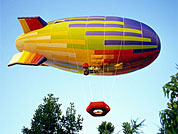scents and tastes to delight the senses

Switzerland's Givaudan is a world leader in fragrances and aromas, but the company's products remain hidden behind their famous clients' brands.
At the firm’s research facility just outside Zurich, scientists aren’t just busy mixing chemicals, but grappling with some of nature’s most alluring qualities.
For Roman Kaiser, Givaudan’s own fragrance hunter, discoveries take place a long way away from his laboratory in Dübendorf. For years, he’s picked up his kitbag and headed off to exotic locations, seeking new scents for the company’s customers.
Two of his most recent trips took him to the jungle treetops in French Guyana and Madagascar.
Standing on a raft suspended beneath a small airship, Kaiser and his colleagues collect samples from the crown of the trees.
The search for new scents continues closer to the ground as well. But when the team finds a plant whose fragrance interests them, they don’t rip it up.
Instead, they cover the plant’s so-called headspace – the area where its scent can be detected – to collect the compounds it releases into the air. These samples are analysed later to determine the precise chemical mixture.
Detection device
But what makes a scent attractive? Specialists like Kaiser rely on nature’s most refined detection device – the nose.
Kaiser says that over the years, he has built up his knowledge of fragrances, a capacity that, like an experienced wine taster, allows him to pick out the elements that make up a scent.
But he adds that is not enough to
determine what might tickle a client’s fancy. “It’s an adventure when we go out, but we have to come back with results,” he told swissinfo.
When the fragrance hunter gets back to his lab, technology well and truly takes over. No question of chopping down plants to extract the compounds.
“Our field trips aren’t just about identifying sources of fragrances,” Kaiser said. “In fact, by cataloguing plants this way, we are helping protect biodiversity, which is one of our goals on these expeditions.”
Chemical analysis reveals the exact composition of a fragrance.
Breaking it down into various
compounds means it can be then synthesised in the laboratory and modified at will.
Rebuilding compounds has a few advantages.
Estragol, the naturally occurring compound in aniseed, is for example toxic in pure form. By slightly changing the formula, its dangerous properties are eliminated.
Safety
A fragrance or a flavour developed at Givaudan is tested for toxicity and environmental impact.
“Our products go worldwide, so they have to pass clearance tests everywhere before being released,” explains Sam Derrer, vice president
of fragrance chemistry.
The chemists aren’t creating new fragrances haphazardly either. According to Derrer, human physiology limits their number: if you can’t smell it (or maybe too much), there’s no point in selling it.
Researchers are also trying to tailor compounds to humans by cloning olfactory gene receptors.
Another limiting factor is cost. The more complex a compound is, the more money it takes to produce.
Producing flavours for the food industry requires a different approach. “People are more conservative when it comes to flavours,” says flavourist Thomas Hefti.
What most people don’t realise is that they recognise these flavours mainly via their sense of smell. Their taste buds only detect four – or maybe six – basic tastes: sweet, salty, sour and bitter, as well as two others known as unami and monosodium glutamate.
Around 60 to 70 per cent of flavours sold are exactly the same as natural compounds. The rest are variations.
Analysing the headspace of a banana, for example, will give the 30 to 50 chemicals that make up its flavour. Hefti says that by tweaking one or the other of the chemicals, you create variations.
The trick is then to reproduce the flavour all over the world before
deciding to pursue its production.
“Producing flavours is a mix of science, inspiration and experience,” Hefti told swissinfo. “We are still developing a common language to describe them.”
To overcome this problem, Givaudan has developed its Virtual Aroma Synthesiser. Machines in different countries can be programmed to produce the same combination of chemicals.
But are we facing standard tastes and fragrances the world over? Not very likely it seems.
A quick walk through the production centre reveals that customers in different countries have very different and very specific tastes.
Enough at least to keep the researchers at Givaudan busy for many years to come.
swissinfo, Scott Capper in Dübendorf
Léon Givaudan founded the company in 1898, but it can trace roots back to the French Revolution.
The Roche pharmaceutical firm of Basel acquired Givaudan in 1963.
Givaudan was spun off from Roche in June 2000 and is now an independent company, traded on the Swiss Stock Exchange.
In 2002 the company acquired Nestlé’s flavour business FIS.
Givaudan, the world’s largest maker of fragrances and flavours, saw net profit rise by 21 per cent to SFr406 million ($310.6 million) in 2005.
Group sales reached SFr2.78 billion, a growth of 2.5 per cent in local currencies.

In compliance with the JTI standards
More: SWI swissinfo.ch certified by the Journalism Trust Initiative

You can find an overview of ongoing debates with our journalists here . Please join us!
If you want to start a conversation about a topic raised in this article or want to report factual errors, email us at english@swissinfo.ch.